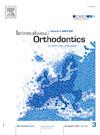Comparative evaluation of propolis, fluoride and probiotic mouthwashes on streptococcus mutans and oxidative stress in fixed orthodontic patients: A triple-blind, randomized controlled trial with 9-month follow-up
IF 1.9
Q2 DENTISTRY, ORAL SURGERY & MEDICINE
引用次数: 0
Abstract
Background
Fixed orthodontic appliances increase the risk of enamel demineralization due to plaque accumulation. While fluoride mouthwash is well established, propolis and probiotic formulations are emerging alternatives with antimicrobial and anti-inflammatory potential.
Aim
To compare the effects of propolis, fluoride, and probiotic mouthwashes on Streptococcus mutans levels and oxidative stress (8-OHdG) in patients undergoing fixed orthodontic treatment.
Materials and methods
Of 120 patients screened (March 2022–February 2023), 90 were randomized into three groups (n = 30 each): propolis, fluoride, and probiotic. S. mutans was quantified at baseline, 30 days, 3-, 6- and 9-months using Q-PCR. Salivary 8-OHdG was measured using ELISA. Dietary and oral hygiene behaviours were monitored through a mobile app, interviews and 24-hour dietary recalls.
Results
S. mutans levels (log10 CFU/mL) significantly decreased (P < 0.001) at 9 months: from 4.35 ± 0.45 to 0.89 ± 0.06 (propolis), 4.42 ± 0.49 to 2.74 ± 0.18 (fluoride), and 4.38 ± 0.50 to 3.21 ± 0.06 (probiotic). Ct values increased accordingly, confirming reduced bacterial load. Salivary 8-OHdG (ng/mL) declined significantly (P < 0.001): 3.8 ± 0.8 to 0.32 ± 0.14 (propolis), 3.9 ± 0.7 to 1.32 ± 0.18 (fluoride), 3.8 ± 0.6 to 2.42 ± 0.22 (probiotic).
Conclusion
Propolis mouthwash produced the greatest reductions likely due to the combined effect of standardized extract and essential oils added for taste. Fluoride remained effective for microbial control, while probiotics offered modest benefit. High compliance strengthened these findings. Further studies should isolate active components and assess long-term effects in broader settings.
蜂胶、氟化物和益生菌漱口水对固定正畸患者变形链球菌和氧化应激的比较评价:一项随访9个月的三盲、随机对照试验
背景:固定正畸矫治器由于牙菌斑的积累,会增加牙釉质脱矿的风险。虽然含氟漱口水已经很成熟,但蜂胶和益生菌制剂是具有抗菌和抗炎潜力的新兴替代品。目的比较蜂胶、氟化物和益生菌漱口水对固定正畸治疗患者变形链球菌水平和氧化应激(8-OHdG)的影响。材料与方法筛选120例患者(2022年3月- 2023年2月),90例随机分为蜂胶组、氟化物组和益生菌组,每组30例。采用Q-PCR在基线、30天、3个月、6个月和9个月对变形链球菌进行定量。采用ELISA法测定唾液8-OHdG。通过手机应用程序、访谈和24小时饮食回顾来监测饮食和口腔卫生行为。突变体水平(log10 CFU/mL)显著降低(P <;0.001):从4.35±0.45到0.89±0.06(蜂胶),从4.42±0.49到2.74±0.18(氟化物),从4.38±0.50到3.21±0.06(益生菌)。Ct值相应升高,证实细菌载量降低。唾液8-OHdG (ng/mL)显著下降(P <;0.001): 3.8±0.8,0.32±0.14(蜂胶),3.9±0.7,1.32±0.18(氟),3.8±0.6,2.42±0.22(益生菌)。结论蜂胶漱口水的减脂效果最大,可能是标准提取物和调味精油共同作用的结果。氟化物对微生物控制仍然有效,而益生菌则提供适度的益处。高依从性加强了这些发现。进一步的研究应分离出有效成分,并在更广泛的环境中评估长期效果。
本文章由计算机程序翻译,如有差异,请以英文原文为准。
求助全文
约1分钟内获得全文
求助全文
来源期刊

International Orthodontics
DENTISTRY, ORAL SURGERY & MEDICINE-
CiteScore
2.50
自引率
13.30%
发文量
71
审稿时长
26 days
期刊介绍:
Une revue de référence dans le domaine de orthodontie et des disciplines frontières Your reference in dentofacial orthopedics International Orthodontics adresse aux orthodontistes, aux dentistes, aux stomatologistes, aux chirurgiens maxillo-faciaux et aux plasticiens de la face, ainsi quà leurs assistant(e)s. International Orthodontics is addressed to orthodontists, dentists, stomatologists, maxillofacial surgeons and facial plastic surgeons, as well as their assistants.
 求助内容:
求助内容: 应助结果提醒方式:
应助结果提醒方式:


